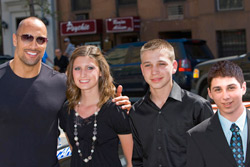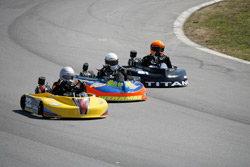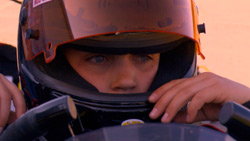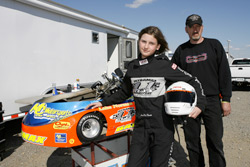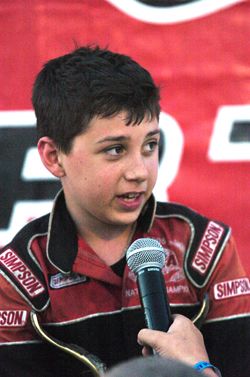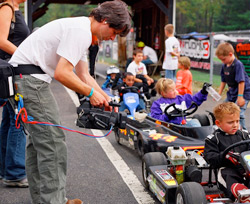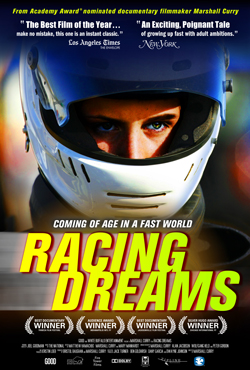NewYorkology

Documentaries dominate Tribeca Film Festival
by Tim McGonagle
NewYorkology film columnist Tim McGonagle was orphaned in a revival theater in Boston, Mass. in the mid-1970s. While other kids were outside playing tag, he was busy absorbing the films of Buster Keaton, Akira Kurosawa and the inappropriate-for-his-then-age, John Cassavettes. Currently he contributes to the “Noir of the Week” film website and maintains a blog of his own. Here’s his second set of reviews (first set here,) from the 2009 Tribeca Film Festival.
Three world premiere documentaries are standouts at this year’s Tribeca Film Festival. While there are many to choose from, here are a few that are all well worth the price of admission and then some.
Racing Dreams (2009) – World Premiere
There is a scene in Racing Dreams when a mother of a young kart racer tries to explain the depth of her family’s passion for racing. She can’t understand how anyone could not love competitive racing. Yet she wonders why anyone would sit in the sun watching guys try to hit a ball with a stick for three hours. I felt the exact opposite of her view about racing vs. baseball: Why would anyone want to sit in the sun watching guys take a left turn for three hours? At least that’s what I thought before seeing Marshall Curry’s stellar documentary Racing Dreams.
Over six months, the film follows the lives of three pre-adolescents who are immersed passionately in the world of kart racing, which is to NASCAR what Little League is to Major League Baseball. These racing karts are not toys: They reach up to 80 miles an hour and travel only one inch off the track surface.
Curry does a great job of explaining the basics and intricacies of racing by using clear, visual guides to enlighten the novice. The racing footage is phenomenal, well edited and extremely exciting. This isn’t what the film is about however. Racing Dreams is about Josh, Annabeth and Brandon.
The three kids are unique talents in the world of kart racing, yet their problems and lives away from the track are not unique to their age. 12 year-old Josh has raced since he was five. The combined weight of his competitive racing trophies could easily surpass that of an M1 tank. A sharp and articulate young man for his age, Josh examines and mimics the styles of professional NASCAR drivers. Not only does he learn from their techniques on the track, but perhaps more importantly, their proficiency with conducting interviews and product endorsement.
Annabeth is a bright and charming young lady in the making. Fairly common for her 11 year-old age is a bedroom that’s girly and heavy on the color pink. The exceptions being a life-sized NASCAR driver stand-up display next to her bed and other racing paraphernalia. Annabeth is determined to be the first woman to win the Daytona 500 (the Superbowl of NASCAR) and believes her ability on the track is a, “God given talent.” Annabeth feels like most kids her age with one difference: “When you’re 11 or 12 years old, everyone always tells you what to do. But when you are racing, you are totally independent. You have to decide whether to pass that guy. It’s totally up to you.” The vast majority of 11 year olds aren’t passing anyone at 70-plus miles an hour while in a driver’s seat.
Brandon is a hilarious and impish 13 year-old. He has a proclivity to lose his temper and was disqualified from the previous year’s kart racing championship (that he had all but won) for “rough driving.” He has been raised by his supportive grandparents as his mother and father have both drifted in and out of his life due to drug addiction and incarceration. Brandon is trying to find his way in his young but tumultuous life. For him, racing is not only a special ability he has but also an escape from his sometimes difficult home life: “When I get to the track everything else goes away – I don’t think about nothing except racing.”
The world of competitive kart racing and the devotion these kids and their parents show it is amazing. Unlike Little League, the cost of racing is approximately $5,000 per race so sponsorship and fundraising are crucial elements to remain competitive and relevant. All the families make sacrifices to facilitate their kid’s racing. Whether it is taking on an extra job, spending the family savings and especially the copious amount of time working on the carts and driving around the country from race to race every other weekend – kart racing is certainly not the same as dropping your child off at soccer practice a couple times a week.
The kids featured in the film make sacrifices with their time, friends and many other normal things pre-adolescents do at their age. Additionally, the kids are all at a crossroads. They’re at the point where a personal and professional decision must be made to determine if these young drivers will go to the next level of racing (the NASCAR minor leagues so to speak.) Racing Dreams explores that crux in the kids’ ages where they start to truly form as individuals and begin seriously envisioning their future as adults. When they dream about these possibilities they seem exciting, limitless and daunting.
At one point Annabeth feels conflicted about all she is giving up to race, realizing that, “All these other doors are opening for me. … It’s hard for an 11, 12, 13 year-old to think about what they want to do for the rest of their life.” The wonder and anxiety of Annabeth’s questions is a universal theme that has resonated with every adult at one point in their young life. It is this uncertain and wondrous feeling where we are uninhibited to dream is what Racing Dreams captures so well and makes for compelling cinema at its best.
April 28, 2009
